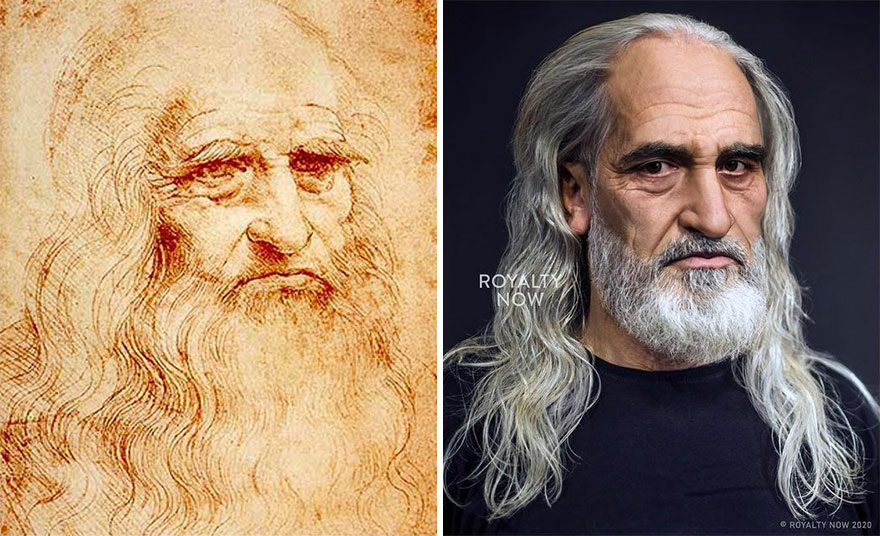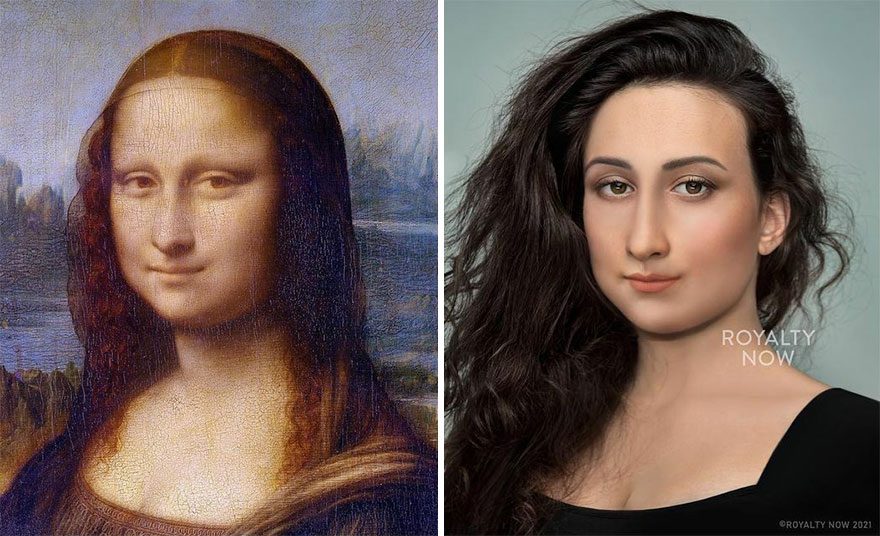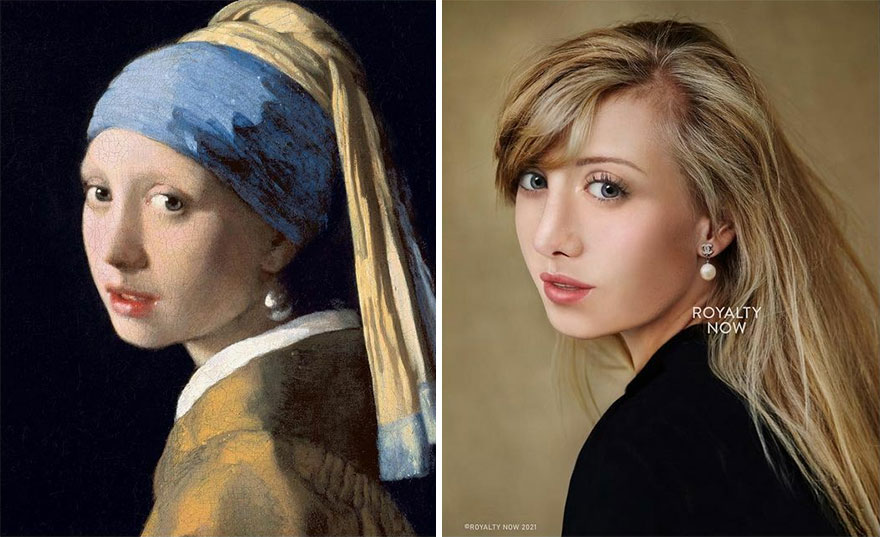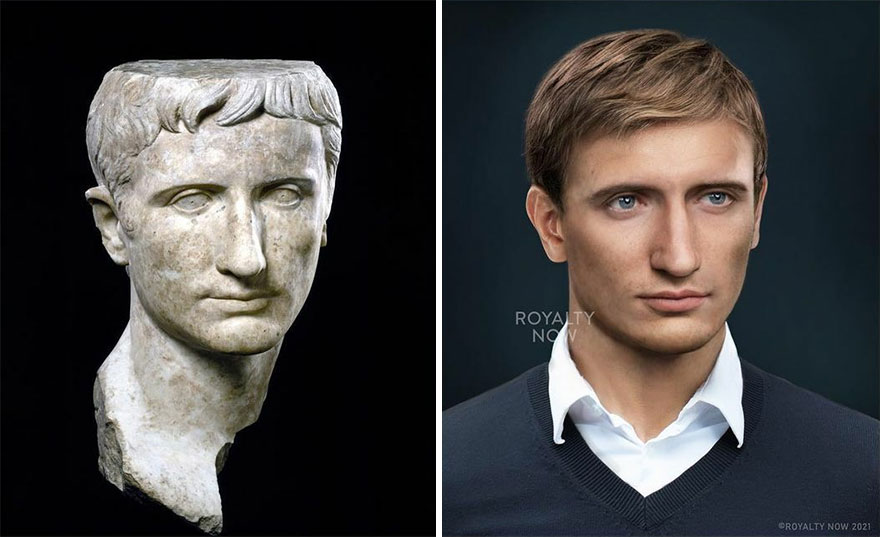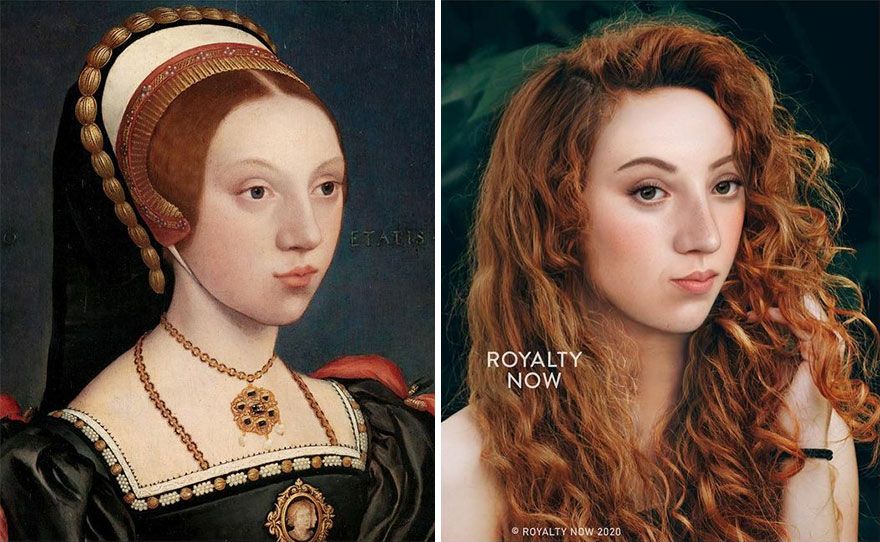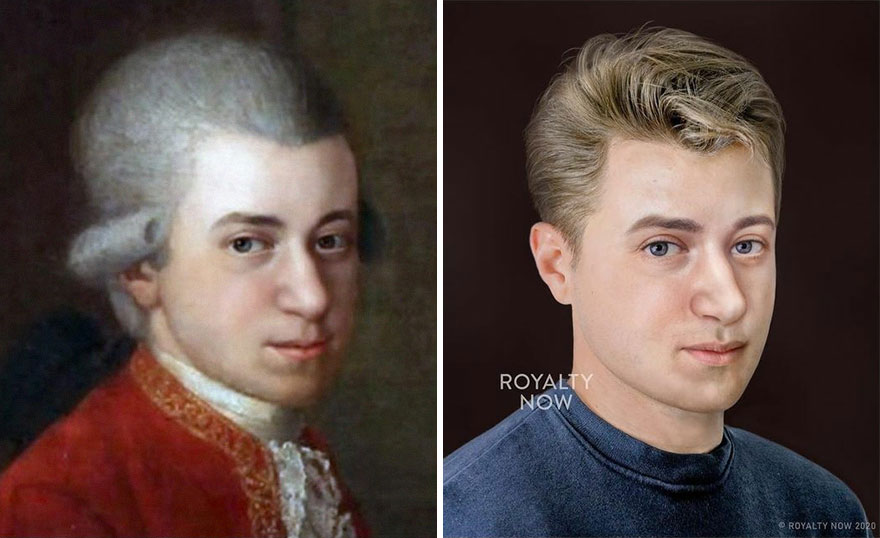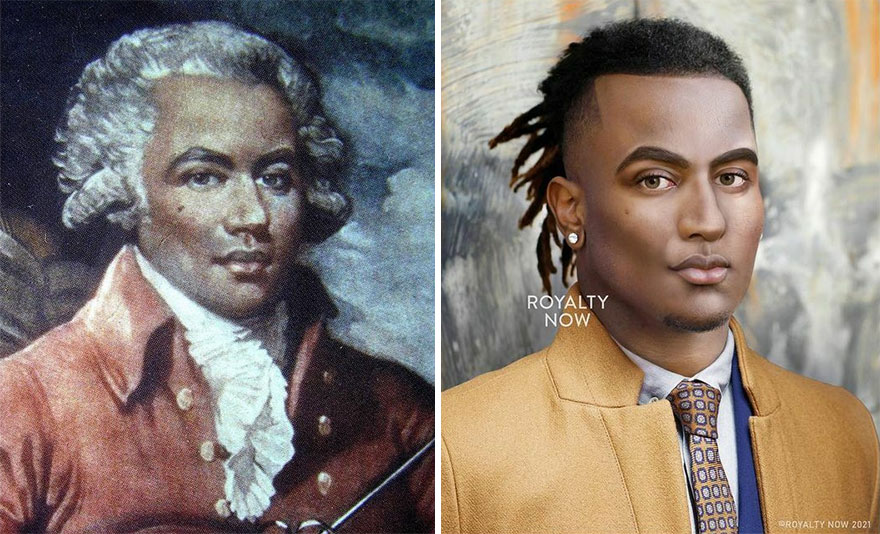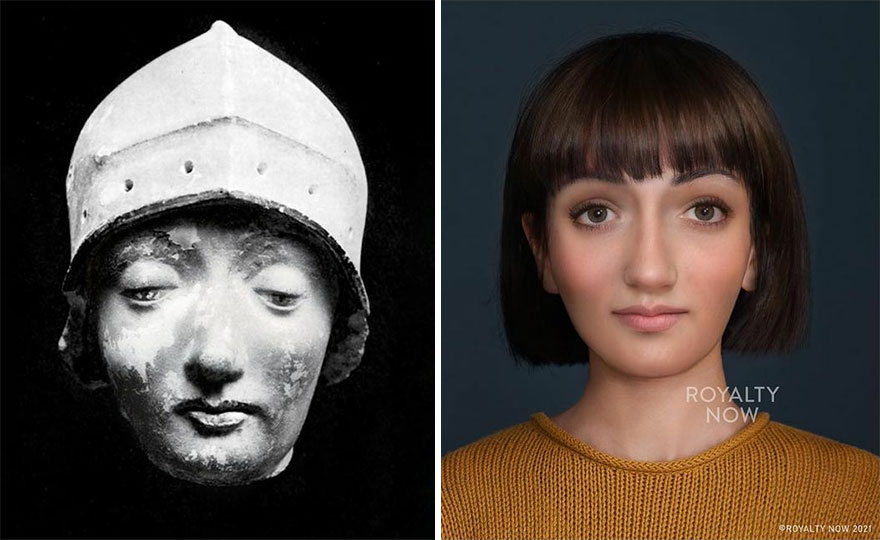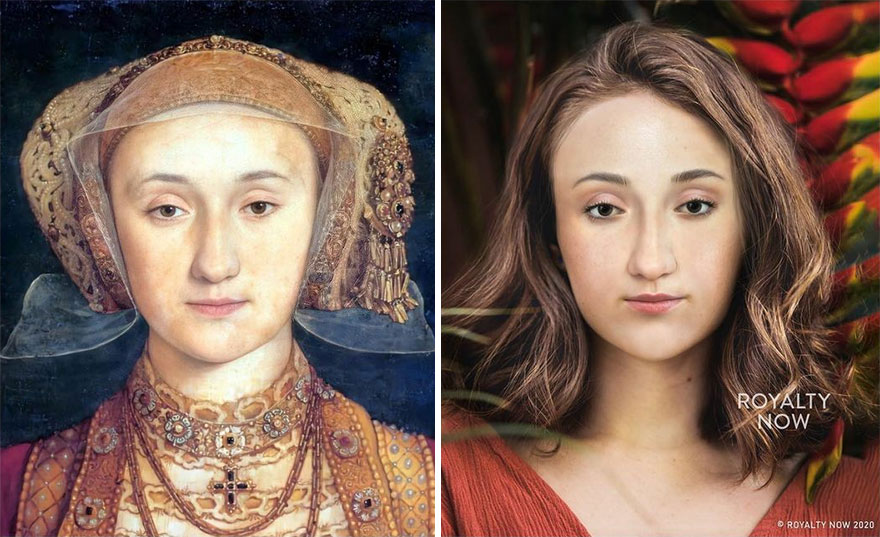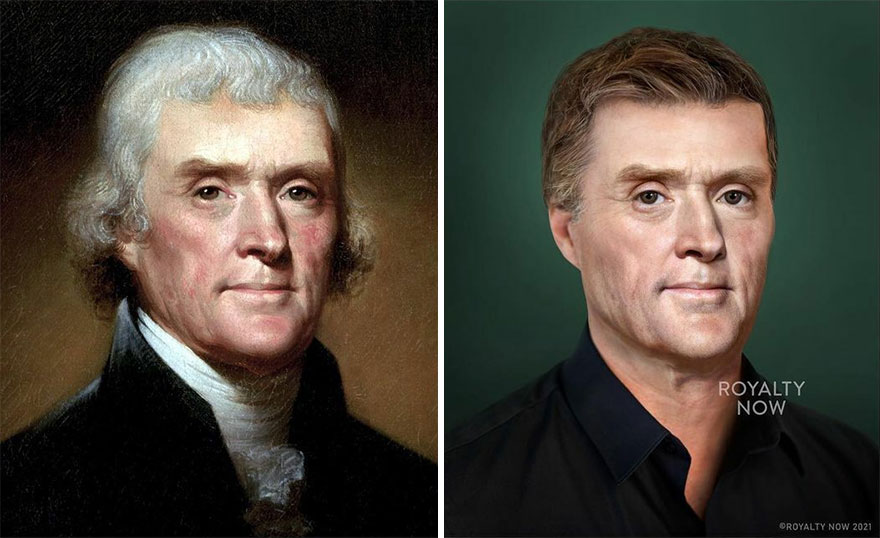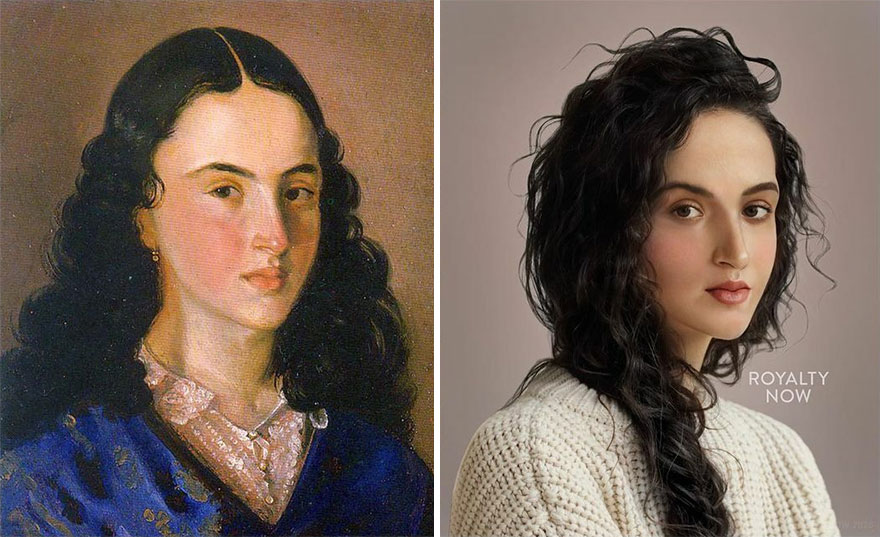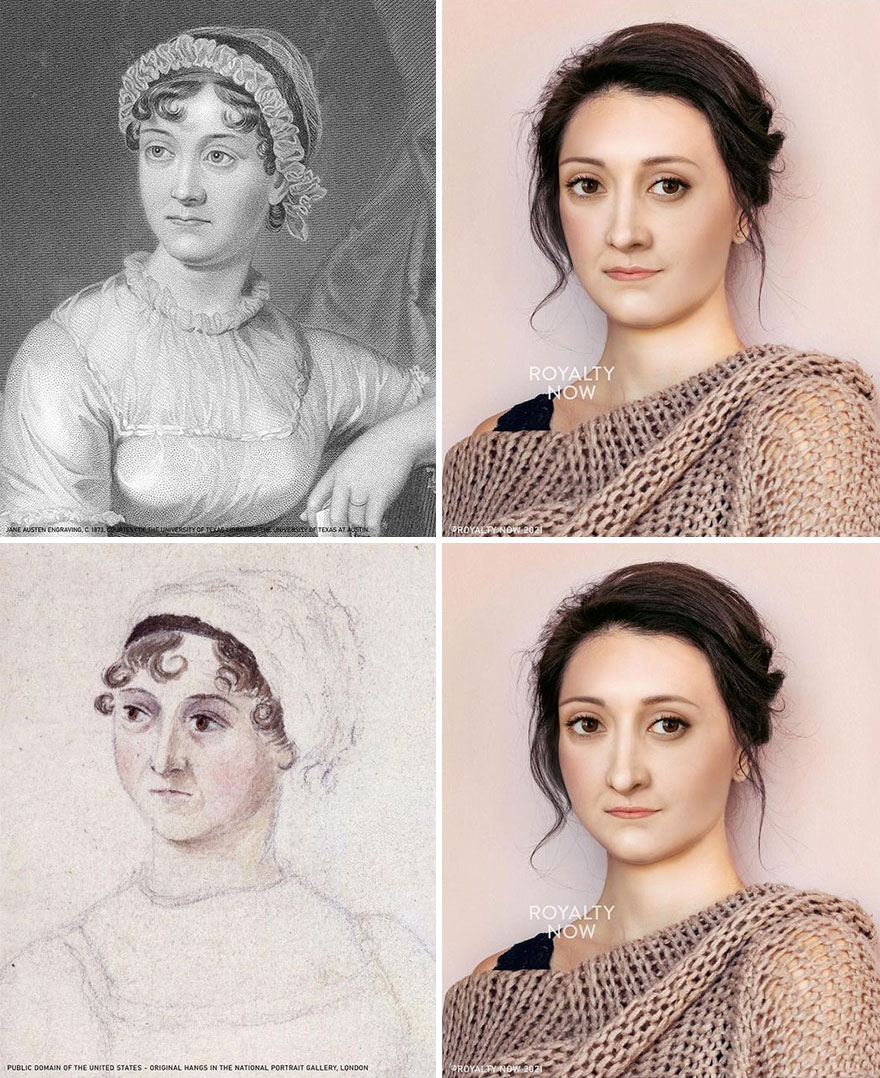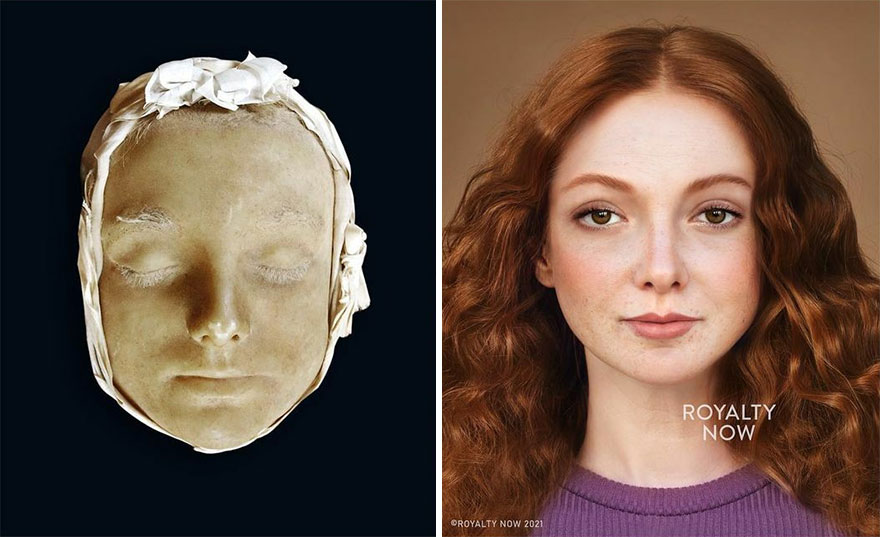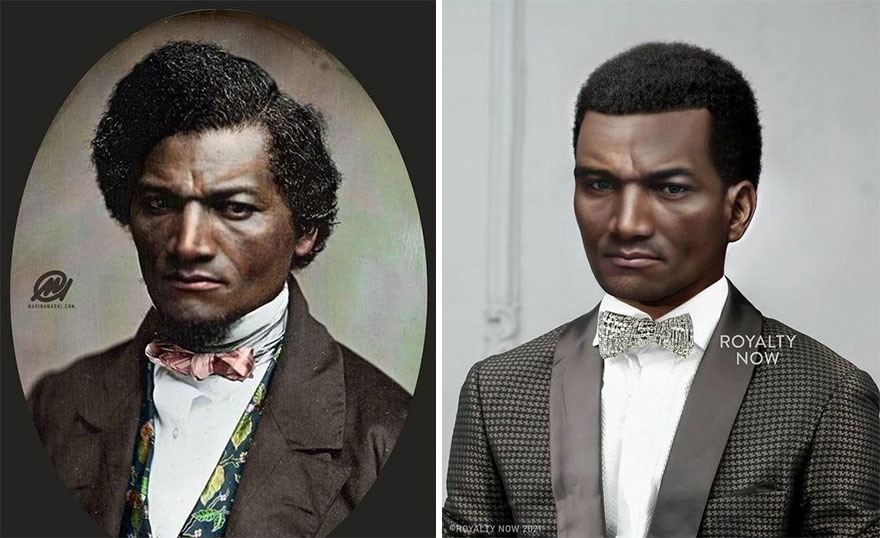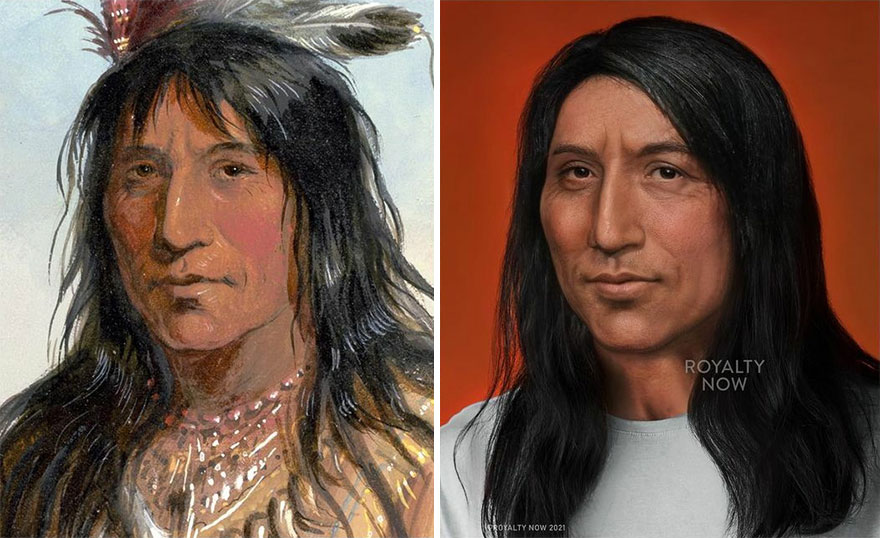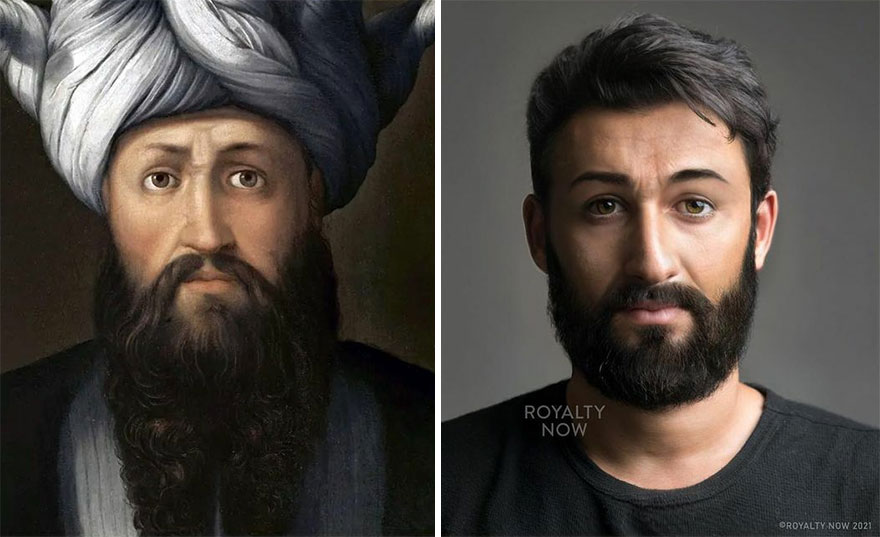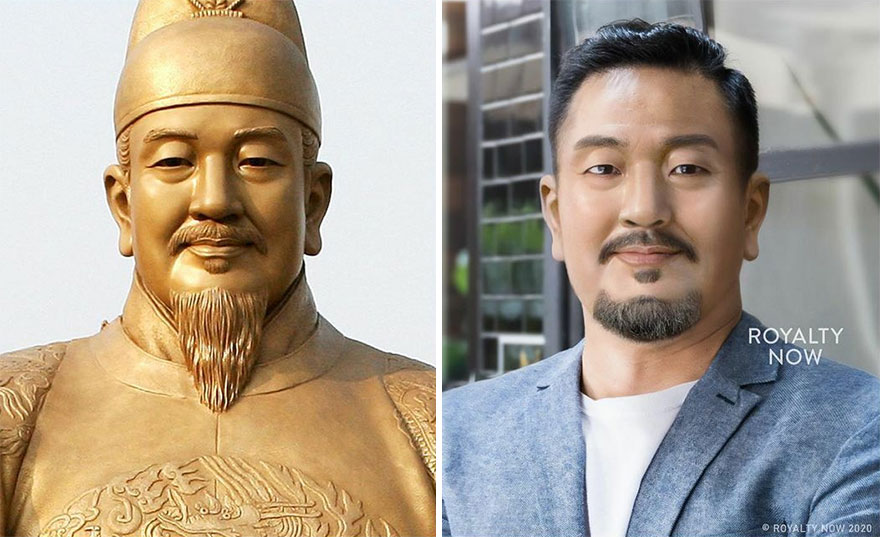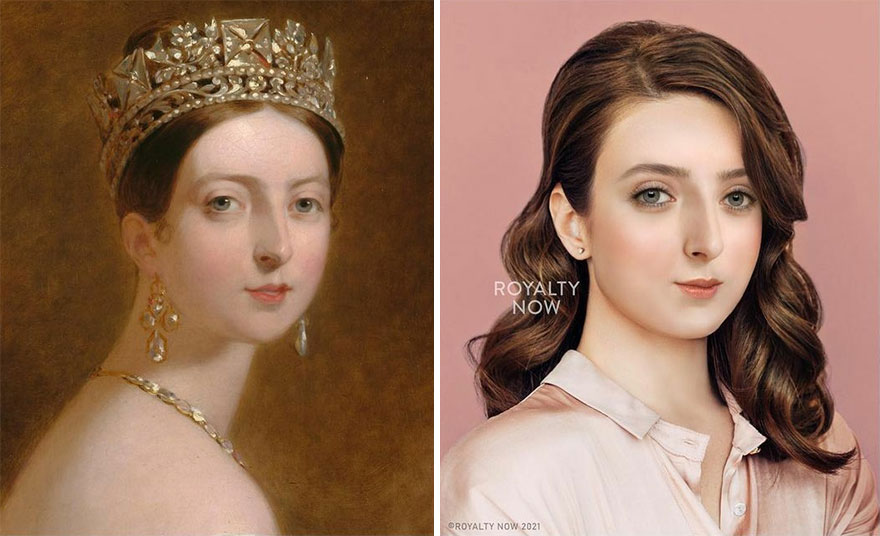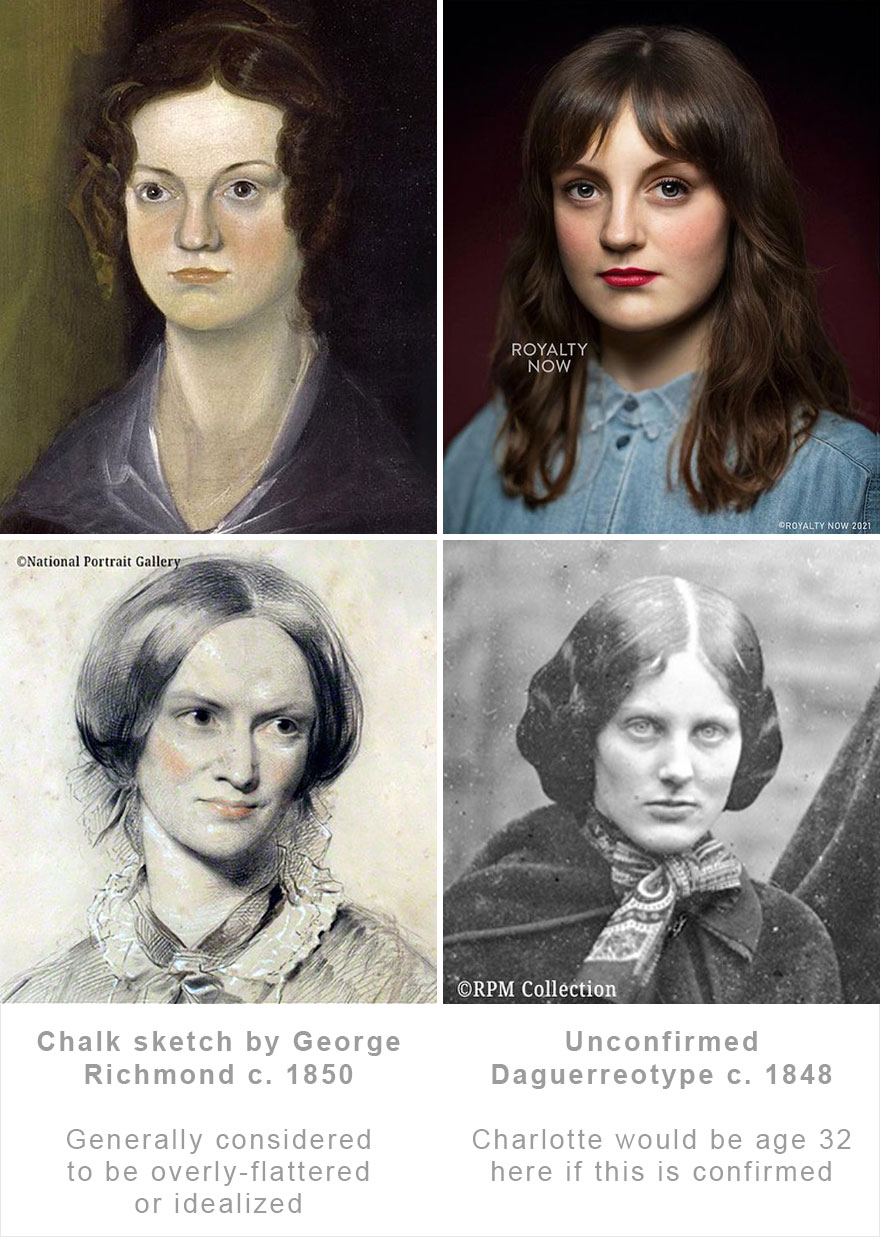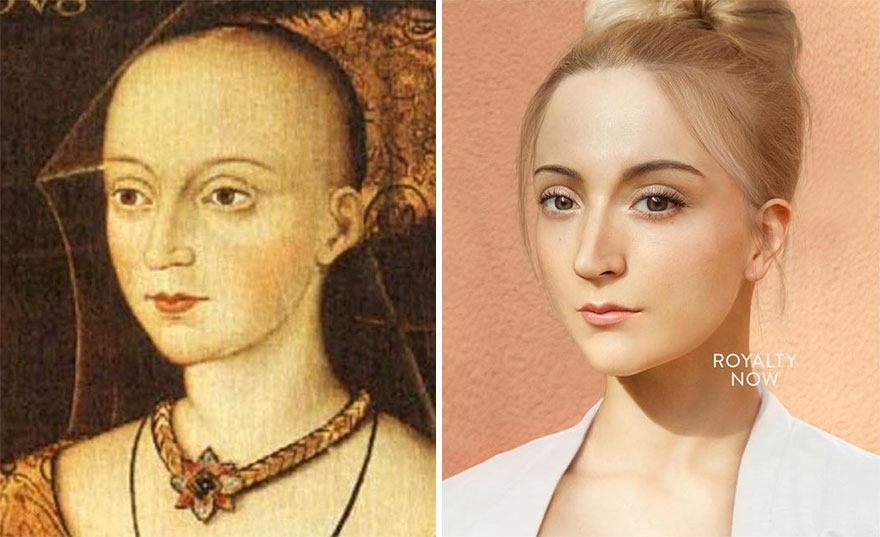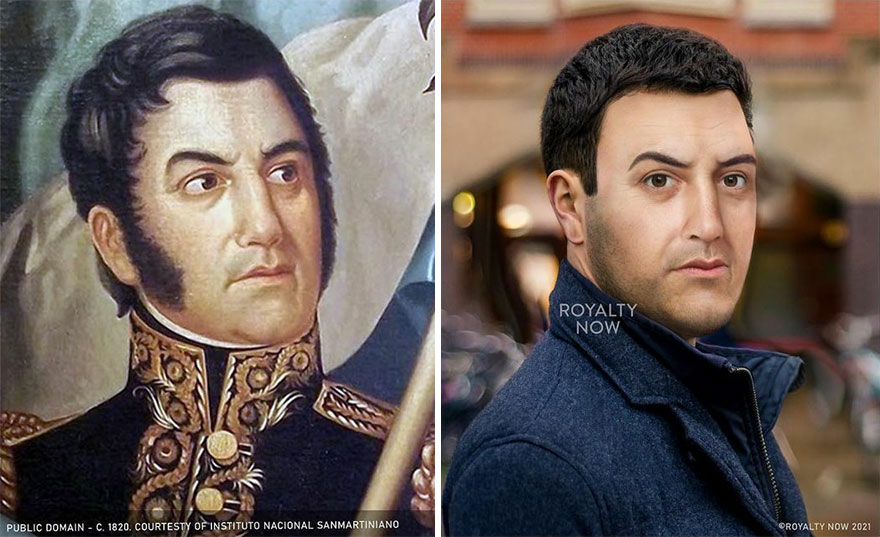If you’ve ever looked at the bust of Nefertiti or Julius Caesar, you may have wondered what they’d look like in today’s world. Well, the Dallas-based artist and graphic designer Becca Saladin has always been fascinated by historical facts and archaeology. “Yet, I always felt separated from the figures. I always thought of history more like a movie than a series of real events,” she explained earlier.
So in order to see historical events and the famous people the way they actually happened and the way they actually looked, Becca created her Royalty Now series that instantly went viral. By combining photography, editing and digital drawing, Becca comes up with incredibly modern and realistic versions of people we only see in movies and history books.
This time, we are back with some of Becca’s most recent work featuring Mona Lisa, Mozart, Leonardo da Vinci, and you name it… Scroll down, upvote your favorites and be sure to check out our previous posts with Becca’s recreations here, here, and here.
More info: Instagram | TikTok | Facebook | Etsy | Patreon
This post may include affiliate links.
Leonardo Da Vinci
“I think this one has been requested for a long time, but I finally worked up the courage to work from the only almost-universally agreed upon portrait of Da Vinci – his self portrait as an older man from around 1512. Of course there are many portraits that are presumed to be younger versions of Da Vinci, even men & women from the many portraits he created are sometimes thought to be sly hidden self-portraits. We also don’t have any information on his skin or eye color, although his hair may have been a medium-brown in his youth based on some unconfirmed portraits. We also know about his jovial personality, conscientiousness, love for animals, and well-groomed appearance. Da Vinci is obviously one of the worlds greatest jack-of-all-trades – not only an incredible artist but a genius in the areas of anatomy, engineering, optics and even metallurgy. I hope I came close to capturing the spirit of this great man.”
Mona Lisa
“I really like this new version of Mona Lisa as a modern-day Italian woman.”
Girl With A Pearl Earring
“I don’t usually do famous paintings, but I’ve always been really fascinated by Girl with a Pearl Earring, far more than the Mona Lisa or other famous portraits. Painted around 1665, this is Johannes Vermeer’s most famous painting. This genre of painting is considered a “Tronie” – a painting of an imaginary figure or character, meant to exaggerate an expression or meaning. I’m sure Vermeer used a model for this work, but we don’t know much about her at all. We don’t even know the color of her hair, so I’ve made some guesswork here. She is meant to represent an ideal young beauty of the time. The reason this painting is so captivating is in part because of Vermeer’s use of light and shadow. The highlights on her lips and eyes and the barely visible contour of her nose all guide the viewer in. It’s also quite different from much of the other stiff portraiture from this time period, with her parted lips and direct gaze.”
Caesar Augustus
“Augustus, born Gaius Octavius, was the great nephew of Julius Caesar and his heir after Julius Caesar was assassinated. Augustus was incredibly intelligent and skilled at diplomacy, and became the first emperor of the Roman Empire, reigning for 40 years. Augustus reigned over a fairly peaceful Roman Empire for the first time in several centuries, known as the Pax Romana, which he helped negotiate and put into place. Augustus turned out to be a master at civil politics, and throughout his reign he reformed the taxation system, the transportation system, the Roman police and fire services, and the city’s architecture. He also greatly expanded the empire.
.
There are dozens of statues of Augustus that were created during his lifetime, and they all share very similar features, so it’s quite easy to imagine his facial structure. The Romans – especially Augustus himself – greatly admired Greek sculpture, and the youthful, idealized look of his portrait statues is a result of that. So Augustus himself may look too young or too handsome in this sculpture – probably both. Where it gets tricky is his coloring. There is a long history of whitewashing Romans, especially by those who would say they were Nordic-looking. Romans are considered “white” as a classification of race, but obviously caucasian people look incredibly different across cultures.
We only know about the appearance of Augustus through the historian Suetonius, who was writing over a hundred years after the death of Augustus but may have had sources now lost to us. He describes Augustus as having Bluish Grey eyes and light brown or even reddish hair, describing him as very good-looking, with skin “between dark and fair.” The latin words used to describe his coloring have controversial modern translations and can be interpreted very differently, so it’s important to note that this is only one interpretation of how he could have looked.”
Katherine Howard
“So, many of you know there are no confirmed portraits of Katherine Howard (it’s a similar situation to Anne Boleyn because they were both executed, therefore many portraits would have been destroyed or painted over). I decided to use this one which has a decent chance of being the fallen Queen, but as I said it’s not confirmed. There are also limited descriptions of her looks – I went with curly hair here because it looks like it’s a combed-down curly on the original portrait.”
Wolfgang Amadeus Mozart
“I think most know that Mozart is one of the most famous classical musicians of all time – starting as a child prodigy. He naturally had fair hair and large blue eyes, and seemed like quite the character according to his friends. They described him as a small man, very fond of punch, with a dirty sense of humor. He was apparently never standing still – always fidgeting or seeming to be pondering something. There are several confirmed portraits of Mozart painted during his lifetime. The most accurate of which was painted by his brother-in-law, and is believed to be unfinished (swipe to see that one). I couldn’t use that image because the quality was so poor. Mozart has been described as the most famous person whose true likeness is the least recognized.Mozart’s sister Nannerl stated that “I have to say that I have never seen so many portraits (of my brother) that are so different when seen side by side, but that nevertheless essentially all look like him.””
Chevalier De Saint-Georges
“Chevalier de Saint-Georges (Joseph Bologne, shown here in 1787 around age 41), was considered one of the most accomplished men in Europe during his lifetime. His list of achievements include classical composer, virtuoso violinist, symphony conductor in Paris, champion fencer, and military leader. He was the son of a house slave, Nanon, and her wealthy enslaver George Bologne de Saint-Georges. Nanon was a renowned beauty, and George seemed to have genuine affection for both mother and child. George funded the young Joseph’s extensive education, which set the stage for his accomplishments later in life.
.
Joseph (Saint-Georges) was brilliant, handsome, and charming. He soon dazzled Parisian society. Even Mozart was said to be jealous of him. Marie Antoinette attended his operas on several occasions. However, with all of his skills and charms, Saint-Georges still faced racism in pre-revolutionary France. He was constantly and continually denied the privileges of white men, including becoming the next director of the Paris opera – a post which was denied to him when a few of the opera’s leading ladies complained. When the revolution proclaimed the equality of all men in 1789, Saint-Georges joined the cause. The latter half of his life was devoted to military pursuits until his death in 1799. There is a lot more to his military career as well, but too much to put here. It is rare in history to find a man with such a broad range of talents, and I had a great time creating his modern portrait.”
Joan Of Arc
“I wanted to finally attempt an artistic depiction of Joan of Arc (Jeanne d’Arc in her native French) despite the fact that we have absolutely no contemporary portraits of her. This is different than my usual posting, so keep in mind I’ve taken huge artistic liberties with even the statue I’ve worked from, and included some elements from physical descriptions of her. What we know about her appearance is that she was short (about 5’2”) and muscular with a short neck. She had short black hair – artistic depictions of her actually popularized the bob hairstyle in the early 20th century. We also know she had prominent, wide-set eyes and a darker than average complexion due to her peasant upbringing in the sun. She was also said to be reasonably good-looking with a happy expression and quiet demeanor. I have a YouTube creation & explainer video on my channel Royalty Now Studios if you’re interested in checking that out.
.
The statue that I’ve worked from is a statue head of St. Maurice from a church in Orleans. Based on the location and 15th century creation date, combined with some features matching her physical descriptions, there is a general agreement that it is a representation of Jeanne d’Arc. It looks as though the sculptor lacked some skill and finesse on the top half (eyes don’t generally look that frog-like), so I’ve adjusted artistically there.
.
I don’t have room to talk about Joan’s fascinating life here, but there are some fantastic & reputable sources just on the first page of google that you can get some great info from if you’d like to learn more about the warrior maid from Orleans.”
Anne Of Cleves
Thomas Jefferson
“Thomas Jefferson, shown here in 1800 at age 57, is one of the most famous Founding Fathers & Presidents in US history. A quick note about his depiction – Jefferson was famous for having red or reddish brown hair. I’m not sure what color it was at 57 or whether he’s wearing a powdered wig in the original (he likely was), but I’ve gone for a salt and pepper look for his modern-day version.
.
Jefferson’s long political career began during the American Revolution, when he represented Virginia in the Continental Congress that adopted the Declaration of Independence of which he was the main author. He served as the Governor of Virginia, the Nation’s first Secretary of State, the Vice President, and later as the third President in 1801. Jefferson was a proponent of democracy, republicanism, and individual rights, motivating American colonists to break from the Kingdom of Great Britain and form a new nation. He was also a big proponent of religious freedom, shunning organized religion and adopting a more philosophical approach.
.
Despite all of his glory as a statesman and founder of America, it’s important not to gloss over other parts of his legacy, like the Louisiana purchase and westward expansionism, which prompted Indian tribal removal from the territory. Jefferson also claimed ownership of over 600 slaves during his lifetime. He also had a longstanding relationship with Sally Hemings, a woman of mixed race, which is often romanticized but began when she was only 14 and he was 44. He was certainly a man of many shades of grey, as there are harsh details about his life that are rightly criticized, as well as many ideals he stood for that we still share today, such as religious freedom.”
Fayum Mummy Portraits: Unknown Man
“I’m sure many of you have heard of and been fascinated by the Fayum portraits in the same way I have been over the years. Here I’ve chosen to work from one of my favorites, of what looks to be a young man or teenage boy. It really makes you wonder how he died and what his story was. For those of you who have never seen these pieces of art, the Fayum Mummy Portraits are a series of hundreds of portraits of anonymous individuals painted during the Roman Egyptian period. They are painted in a naturalistic style directly on a panel that was attached to the coffins of the dead. The portraits were made as an artistic tradition in Fayum, an oasis region 150 miles south of Alexandria in Egypt between the 1st Century BCE and the 1st Century AD. The Fayum portraits as a whole are intriguing because of their naturalistic qualities and lifelike appearance, each a portrait of the deceased individual. They do include some stylizations which I tried to correct for in my version here, but overall their appearances are very unique and natural. The style derives heavily from Greco-Roman art traditions. It’s such a fascinating combustion of cultures and art styles. I think I may do a few more of these, as I enjoyed making this one very much.”
Policarpa Salavarrieta (La Pola)
“I’ve been trying to get more South American figures in the mix, and the story of Policarpa Salavarrieta (known as La Pola) fascinated me since a kind follower sent her over a suggestion. This is a posthumous portrait (I couldn’t find any contemporary images), but it captures a lifelike spirit. La Pola is renowned in Colombia for being a revolutionary heroine during the early 1800s. She was born into a politically-active family, with her family fighting against the colonization attempts of Spain. As a young woman, she joined the patriotic groups in the Colombian capital, and began using her skills to infiltrate the colonizing camp. Trained as a seamstress, she was sent to be the official seamstress to Spanish Royals, listening and gaining valuable information about troop movements and other plans. She was exposed and captured when a comrade carrying information that exposed her spying was intercepted by the Spanish. She was sentenced to death by firing squad. Right before her execution, she yelled the iconic words, “Although I am a woman and young, I have more than enough courage to suffer this death and a thousand more!” Her death inspired thousands, and her efforts contributed greatly to a Colombia that is no longer colonized.”
Jane Austen
“I know Jane Austen doesn’t need too much of an introduction, but I was pleased to work on her again. She was one of my first subjects. Now, let me tell you about these 2 different versions. So as I was working on my research for this portrait, I discovered that the only confirmed and verified portrait of Jane is a miniature work by her sister Cassandra Austen, done around 1810 (Second image). It’s important to note that Cassandra was an amateur artist, and the portrait was not considered very successful even by people that knew Jane. However, Cassandra very likely captured at least the essence of her sister here. Other images of Jane Austen were created as derivative works of this one – the engravings in the first and third images are examples of this. Both attempt to capture the features from the original but make them more “official” looking portraits of the famous author. What’s interesting is what the engravers chose to ignore, like the fact that it looks like Jane most definitely had dark eyes, where the engraving shows light. I chose to work from both and make 2 versions. I think the second image is more likely a truer image, with a more hawkish nose, thinner lips, and slanting brows, even where the low quality makes it hard to discern certain features. It has so much life and I love that about it. “
Mary, Queen Of Scots
“I’ve always been struck by this gorgeous death mask, said to be taken from Mary, Queen of Scots directly after her execution in 1587. There is surprisingly little detail to be found about this mask – called the Lennoxlove Mask – that has been passed down through generations. It’s a little unclear if this actually IS Mary. I thought before beginning this portrait that there would be more documentation, but it seems like a “take our word for it” kind of thing. Portraits of Mary from her lifetime look fairly different from this, although they do share the same strong nose, wide-set eyebrows, and dainty upper lip. However, the face shape is painted much differently than depicted here. Mary was said to be a great beauty, and I find her death masks to be much more beautiful than the portraits created of her at the time. I’ve depicted her here in her mid-forties to match her age at execution, which was 44. Another reason to possibly doubt the mask is her serene and youthful features – for being in her mid-forties there is hardly a wrinkle to be found. She was also said to have white hair at the execution because of the stress of her imprisonment, which you would think would also age her skin. I’ve recreated her with her natural red hair here, for a more accurate portrayal of how she would have looked most of her life. Anyway, I’d love to hear your thoughts and theories about this death mask of Mary and whether or not you think it’s her! I know a ton of you are Mary aficionados and I’d love to hear what you think.”
Frederick Douglass
“Frederick Douglass was one of the most eminent human rights leaders of the 19th century. Born as a slave in Maryland with a slave mother and a white father, the mistress of the house he grew up in defied the law by teaching him to read. He eventually escaped slavery at the approximate age of 20. Douglass soon became renowned for his oratory skills, intelligence, and literary fervor. He was a living counter-example to slave-owner’s claims that slaves lacked the intelligence to function as citizens. Douglass wrote several autobiographies, notably describing his experiences as a slave in his Narrative of the Life of Frederick Douglass, an American Slave, which became a bestseller. Frederick supported the equality of all people, including women, Native Americans, Chinese Immigrants, and white people. Douglass became the first black citizen to hold a high public office in the United States. His legacy continues through to this day, and he is one of the most important black figures in United States history.”
Bull Bear (Matau-Tathonca)
“Bull Bear was chief of the Oglala Sioux tribe. According to Karen McWhorter:
In 1834, the Oglala Sioux began to move southward from their traditional home on the Missouri River into the Laramie Plain, historically a shared hunting ground for many tribes. The Sioux’s migration caused tumult among the many Indian cultures who communally used the area, many of whom were longstanding enemies. According to Bernard DeVoto, this painting is “the only portrait of a very famous Indian, really named Bull Bear, the chief of the Oglala Sioux.” On their westward journey, Miller’s caravan met Bull Bear and his men east of Fort Laramie and rode with them to the fort’s gate. In the notes that accompany this portrait, Miller recounts the murder of Bull Bear, which occurred in 1841, years after the artist met the Sioux leader.”
Saladin
“Al-Nasir Salah al-Din Yusuf ibn Ayyub, better known to the western world as Salah ad-Din or Saladin (1137-93) was a 12th century Kurdish Sultan and crusader. He is mainly known for defeating an army of Christian Crusaders at the Battle of Hattin and capturing Jerusalem in 1187. He was uniquely famous during this time period, both in his own lands and in the Western world, capturing the respect and admiration of even his greatest opponent, Richard the Lionheart. Saladin was skilled in warfare, politics, and diplomacy, and was known for his generosity and chivalry.
.
There are unfortunately no contemporary images left of Saladin with the exception of some faded coinage. It’s important to note that this image of Saladin was NOT taken from life – it is a painting by Florentine artist Cristofano dell’Altissimo. The history of the painting is rather convoluted. Originally, a gallery of paintings of Great Men was painted by Paolo Giovio and housed in a purpose-built museum near Lake Como. Dell’Altissimo was commissioned by Cosimo I De Medici to make a set of personal copies of each of these paintings for his own home. It’s hard to tell where Giovio got his source material for this image, or if he painted it from his own imagination – it’s possible that this is a copy of some work lost to us now. Given that it was painted by a European, there may be trends toward making him look more fit for a European audience, although the extent of this is unclear. I believe it’s safe to say he looks like a modern day Iraqi man, which is the modern birthplace of Saladin. I still think it’s a lovely portrait and have been wanting to cover Saladin as that is my surname.”
Sejong The Great
“Sejong the Great (1397 – 1450) was the fourth king of the Joseon dynasty of Korea. He is known for some major accomplishments during his reign, including creating and promoting the Korean alphabet. He encouraged advancements in science and technology, and introduced measures to stimulate economic growth. His reign also included fighting Japanese pirates to the south as well as dispatching military campaigns to the north. Sejong is honored with this very large statue in Gwanghwamun Plaza, Seoul.”
Queen Victoria
“I hesitate to write a long description about the now second-longest reigning Monarch in British history, because so much is already known about her. I love that we have photos of her from later in her life (here she is a very young woman of only 17) that we can compare these early portrait depictions to.”
Charlotte Brontë
Charlotte Brontë (1816 – 1855) was an English novelist and poet, the eldest of the three Brontë sisters whose novels became classics of English literature. Charlotte is most famous for her novel Jane Eyre. I greatly enjoyed learning about Charlotte and her strong personality through my research into her looks. She was said to be less than five feet tall with indiscriminate yet enchanting eyes. She was strong-minded, clever, shy (but ready to argue her beliefs), and apparently hated teaching young children.
.
I struggled a bit with which portrait to use here. I found a great source about her looks that talks about the confirmed images we have of her. I’ve used this painting by her brother Branwell as my main reference, but pulled in some visual references from others as well (see next slides). Only three undisputed images of Charlotte exist – this painting by Branwell is one of them and was painted when she was probably 18 years old. It is generally considered an “unflattered” portrait – meaning it doesn’t try to beautify her and the skill of the painter is questionable. The other is a chalk drawing from later in her life by George Richmond, but this is considered to be overly flattering by elongating her face and forehead. The third is a possible photo of Charlotte, although this is unconfirmed. The face shape looks correct, but the eyes look far too blue to be her based on other accounts.
Elizabeth Woodville
“Elizabeth Woodville, England’s “White Queen,” was Queen of England as the wife of King Edward IV from 1464 until his death in 1483. She was the mother of former subject Elizabeth of York (you can definitely see some family resemblance in the nose and eyes) as well as the grandmother to King Henry VIII. Surprisingly, no contemporary image of her exists, and this well-known portrait is likely a multi-generational copy of a lost original. There are actually several versions of this portrait with slightly different features. The artistry on this one is a little crude which is why it is hard to imagine her likeness – particularly around the cartoonish nose that I had to adapt. Elizabeth was said to be the “most beautiful woman in the Island of Britain” with “heavy-lidded eyes like those of a dragon.” She almost definitely had a plucked or shaved hairline in this portrait to open her face as was the fashion at the time – I’ve also reigned that in a little bit for my modern version.
.
Elizabeth had such an interesting life as a power player during the War of the Roses, a bitter battle for the throne of England that lasted over 30 years. Called the “White Queen” because she was on the York side (represented by a white rose), as opposed to the Lancasters who were represented by a red rose. I was listening to a podcast the other day about why this time in English history is so fascinating, and I learned that this was one of the first generations of English royals where we actually have knowledge of their personal lives through letters and other sources.”
Terracotta Archer
“I thought it would be fun to bring an individual member of the Terracotta Army to life. The full Terracotta Army was constructed as an afterlife guard to accompany the tomb of China’s First Emperor, Qin Shuhuang, around 210 BCE. Every figure differs in facial features and expression, clothing, hairstyle, and gestures, providing abundant and detailed artifacts for the study of the military, cultural, and economic history of that period. The soldiers do not represent real people specifically, but each one looks unique. Scholars have identified about 10 basic face molds used in the creation of the once-painted figures. Clay would then be added after assembly to provide individualized features to make each figure appear different. The soldier I’ve brought to life is an Archer – shown in the next slide as a full bodied man, ready to deploy his bow (the bow has been lost). At the very least it shows a way that a soldier of a Chinese army could have looked like!”
José De San Martín
“José de San Martín (1778 – 1850, pictured here in his 40s) is known as “El Libertador” of Argentina, Chile and Peru. He was an Argentine general and the foremost leader of the struggle for independence from the Spanish Empire in the southern and central parts of South America. Born to a Spanish soldier while stationed in Argentina, Jose spent only 6 years in South America before returning to Spain. After returning to Spain as a boy, he spent a large part of his adult life serving the King of Spain.
.
There seemed to be a change in San Martin’s loyalties in 1812 when he offered his services to the United Provinces of the Rio de la Plata in Argentina. Despite serving Spain faithfully for many years, he saw the difficulties the provinces were having with the colonial rule of Spain, and chose loyalty to his native-born region over the Spanish Empire. San Martin quickly distinguished himself as a great trainer and leader of soldiers. He began raising armies and strategizing the takedown of Royalist strongholds like Lima.
.
After seizing control of Lima in 1821, San Martín was appointed Protector of Peru. Peruvian independence was officially declared on 28 July. You may remember the former Royalty Now subject Simon Bolivar. After a closed-door meeting between the two men in 1822, Bolivar took over the task of fully liberating Peru. Historians feverishly debate what happened here, because it was after that meeting that San Martín unexpectedly left the country and resigned the command of his army, excluding himself from politics and the military, and moved to France in 1824. San Martín is regarded as a national hero of Argentina and Peru, and one of the Liberators of Spanish South America. The Order of the Liberator General San Martín, created in his honor, is the highest decoration conferred by the Argentine government.”
Catherine The Great
“One thing I wasn’t expecting was how difficult researching her hair color would be. Sources and portraits show Catherine with beautiful blue eyes, but they differ sometimes on her hair. In the show and in one or two sources she is depicted as a blonde, but many more sources and portraits show her with rich dark hair – so that’s what I went with here.
.
Catherine II (born Sophie of Anhalt-Zerbst) was born in 1729 – this portrait was dated to the mid 1760s, so it puts her approximately in her mid 30s. Known as Catherine the Great, she was Empress of Russia from 1762 until 1796 – the country’s longest-ruling female leader. She was married to the inept Tsar Peter III upon arriving in Russia, and came to power in a coup that she organized herself. Under her rule, Russia thrived, growing larger and stronger until it became one of the main powers of Eurasia. Catherine was an admirer of Peter the Great, and embarked on a modernization campaign of Russia. Despite her efforts, Russia still had its shortcomings – Russia was still using serf labor while Catherine ruled – causing several rebellions and uprisings.
Catherine was a supporter of the arts, humanities, and a supporter of the Enlightenment. Many historians agree that Russia was in its “Golden Age” while Catherine ruled.”
Source link : https://www.boredpanda.com/historical-figures-recreated-royalty-now-becca-saladin

